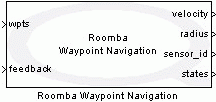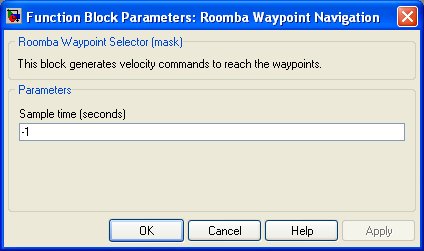

Roomba Waypoint Navigation
Generates motion commands (velocity and radius of curvature) to reach the specified waypoints.
Library
QUARC Targets/Devices/Third-Party/iRobot/Roomba/Applications MATLAB Command Line Click to copy the following command line to the clipboard. Then paste it in the MATLAB Command Window: qc_open_library('quarc_library/Devices/Third-Party/iRobot/Roomba/Applications')
Description

The Roomba Waypoint Navigation block generates motion commands (velocity and radius of curvature) to reach the specified waypoints. It uses distance, and angle sensory data for continuous localization of the robot. The robot's coordinate is updated using the traveled distance and its current angular orientation with respect to its initial position. The updated coordinate may be inaccurate in case of wheel slip. The state output of this block shows the robot's position with respect to current waypoint.
Input Ports
wpts
Specifies the waypoints to be reached. The input must be an n x 2 matrix in which each row is a waypoint. Each waypoint includes orientation
(in degrees) and distance (in mm) of a target position. For example, [90 100; -180 1000] indicates the following motion planning:
feedback
The sensor packet returned by Roomba according to the specified sensor_id.
Output Ports
velocity
Velocity of the robot to reach the target position. Use this output as the velocity input of Roomba Drive block.
radius
Radius of curvature of the robot's motion to reach the target. Use this output as the radius input of Roomba Drive block.
sensor_id
The sensor packet number is either 19 (distance) or 20 (angle). To reach a waypoint, the robot, first, rotates to the target position and moves forward to the target. Hence, this block, first, requests angle sensor packet and then requests distance sensor packet. Use this output as the packet ID input of Roomba Sensor Request or Roomba Query List block. Roomba Query List block.
states
This vector includes
Parameters and Dialog Box

Sample time
The sample time of the block. A sample time of 0 indicates that the block will be treated as a continuous time block. A positive sample time indicates that the block is a discrete time block with the given sample time. A sample time of -1 indicates that the block inherits its sample time.
Targets
|
Target Name |
Compatible* |
Model Referencing |
Comments |
|---|---|---|---|
|
Yes |
Yes |
||
|
Yes |
Yes |
||
|
Yes |
Yes |
||
|
Yes |
Yes |
||
|
Yes |
Yes |
||
|
Yes |
Yes |
||
|
Yes |
Yes |
||
|
Yes |
Yes |
||
|
Yes |
Yes |
||
|
Yes |
Yes |
||
|
Yes |
Yes |
||
|
Yes |
Yes |
||
|
Yes |
Yes |
||
|
Yes |
Yes |
Last fully supported in QUARC 2018. |
|
|
Rapid Simulation (RSIM) Target |
Yes |
Yes |
|
|
S-Function Target |
No |
N/A |
Old technology. Use model referencing instead. |
|
Normal simulation |
Yes |
Yes |
See Also

Copyright ©2025 Quanser Inc. This page was generated 2025-11-01. Submit feedback to Quanser about this page.
Link to this page.